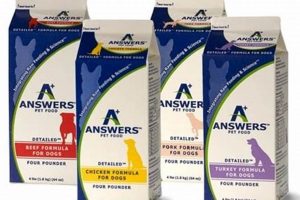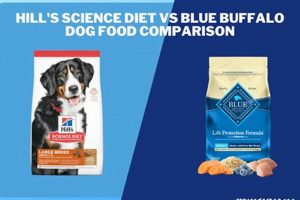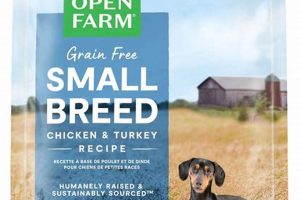The quantity of dry dog food, measured in cups, contained within a thirty-pound bag is not a fixed value. This is because the density of the kibble, which varies significantly between brands and even between different formulas from the same brand, directly impacts the cup-to-pound conversion. A lighter, airier kibble will occupy more volume (cups) per pound than a dense, compact kibble. Therefore, a thirty-pound bag of one brand may yield considerably more or fewer cups than a thirty-pound bag of another.
Understanding the approximate cup yield of a bag of dog food is important for several reasons. Primarily, it assists in budgeting food costs and planning purchasing schedules. Knowing roughly how long a bag will last allows pet owners to avoid running out unexpectedly. Furthermore, this understanding facilitates accurate portion control, which is crucial for maintaining a dog’s healthy weight and preventing overfeeding or underfeeding, both of which can lead to health problems. Historically, owners relied on imprecise methods, but today understanding volume is critical.
To determine the approximate number of cups in a specific thirty-pound bag, one must consult the feeding guidelines printed on the bag itself. These guidelines typically provide information regarding the weight of the food per standardized measuring cup (usually an eight-ounce cup). Using this information, a simple calculation can be performed to estimate the total number of cups contained within the bag. Subsequent sections will detail the method for calculating this estimate and discuss the factors that influence kibble density.
Estimating Volume
Determining the cup quantity within a thirty-pound bag of dry dog food necessitates careful consideration. The following guidelines offer practical approaches for estimating this value and maximizing feeding accuracy.
Tip 1: Consult the Packaging. The single most reliable source of information is the product packaging itself. Dog food manufacturers typically provide a feeding chart and indicate the approximate weight of the food per cup measure. Locate this information before making assumptions.
Tip 2: Account for Kibble Density. Note that differing kibble sizes and compositions influence density. A food comprised of smaller, denser pieces will yield fewer cups per pound than a food with larger, more porous pieces. Visual inspection and comparison to previously used foods can provide a rough estimate of density differences.
Tip 3: Use a Standard Measuring Cup. Employ a standard eight-ounce (240 ml) dry measuring cup for consistent portioning. Kitchen scales can also be used for precise weight measurement, enabling accurate translation between weight and volume.
Tip 4: Calculate the Total Cups. Once the weight per cup is known (e.g., 4 ounces per cup), divide the total weight of the bag (30 pounds, which is 480 ounces) by the weight per cup. In this example, 480 ounces / 4 ounces/cup = 120 cups approximately.
Tip 5: Verify with Smaller Measurements. Before committing to the calculated volume, measure out a smaller quantity (e.g., five cups) and weigh it. Compare this measured weight to the expected weight based on the manufacturer’s information. This cross-validation step enhances accuracy.
Tip 6: Adjust for Individual Dog Needs. Remember that the feeding guidelines on the bag are starting points. Adjust portions based on the dog’s age, activity level, breed, and metabolic rate. Consult a veterinarian for personalized feeding recommendations.
Tip 7: Re-evaluate with New Food. If switching to a different brand or formula, repeat the calculation process. The density of the new food will likely differ, necessitating an adjusted cup measurement.
Accurate estimations of cup quantity, combined with mindful monitoring of the animal’s body condition, will contribute to maintaining a healthy weight and preventing dietary imbalances. Understanding these details aids consistent animal well-being.
These guidelines facilitate a better understanding of portion control, leading to appropriate feeding practices. The subsequent section will focus on the consequences of inaccurate portioning and the importance of regular weight monitoring.
1. Kibble Density
Kibble density exerts a direct and inverse influence on the cup yield from a thirty-pound bag of dog food. Density, defined as mass per unit volume, varies significantly between different dog food formulations. A higher kibble density means that a given weight of food occupies a smaller volume. Consequently, a thirty-pound bag containing dense kibble will yield fewer cups compared to a thirty-pound bag filled with less dense kibble.
The composition and manufacturing processes significantly impact density. For example, dog food formulas with a high concentration of meat meal and minimal fillers tend to produce denser kibble. Conversely, formulations incorporating a higher proportion of grains, vegetables, or air-puffed components typically result in lower density. This difference can easily translate to a discrepancy of several cups when measuring out the contents of a thirty-pound bag. Imagine two thirty-pound bags: one contains a dense, high-protein kibble, yielding approximately 100 cups, while the other contains a lighter, grain-based kibble, potentially yielding 130 cups. Failure to account for density when switching between these formulas could result in significant over or underfeeding, irrespective of adhering to the recommended portion sizes on the packaging.
Therefore, understanding kibble density is paramount for accurate portion control. While manufacturers provide feeding guidelines, these are often expressed in weight (ounces or grams) and sometimes include a cup equivalent, which is often approximate. Accurately assessing a dog’s food portion needs consideration of the food’s density. Estimating the density and subsequently adjusting the cup measurement helps ensure consistent feeding practices, preventing weight fluctuations and maintaining optimal canine health. A crucial note is that food weight is the most precise metric, while estimating based on cup measurements requires an understanding of kibble volume.
2. Manufacturer Guidelines
Manufacturer guidelines represent a crucial, albeit approximate, starting point in determining the cup quantity within a thirty-pound bag of dog food. These guidelines, typically presented on the product packaging, provide recommended daily feeding amounts based on a dog’s weight, age, and activity level. Although the guidelines themselves do not directly state the total number of cups in the bag, they furnish the information necessary to calculate an estimated value. Manufacturers often specify the weight of food contained within a standard measuring cup (usually an 8-ounce cup). This figure, in conjunction with the total weight of the bag, allows pet owners to estimate the approximate number of cups.
However, it is critical to recognize that manufacturer guidelines are just thatguidelines. They are based on averages and may not perfectly reflect the individual needs of every dog. Factors such as breed, metabolism, health status, and environmental conditions can influence a dog’s caloric requirements. Moreover, the stated weight per cup is subject to variation due to differences in kibble density across batches or formulations, even within the same brand. For instance, a manufacturer might state that 4 ounces of food equals one cup. Using this information, one could calculate that a 30-pound bag (480 ounces) contains approximately 120 cups. However, if the kibble is denser than average, the actual cup yield will be lower. Conversely, a less dense kibble will result in a higher cup yield. Therefore, relying solely on manufacturer guidelines without considering individual needs and kibble density can lead to inaccurate portioning and potential health consequences, like weight gain or loss.
In conclusion, while manufacturer guidelines provide a useful framework for estimating the cup quantity in a thirty-pound bag of dog food, they must be interpreted with caution. They serve as a starting point that needs adjustment based on the dog’s individual characteristics, the food’s density, and ongoing monitoring of the dog’s body condition. The reliance on manufacturer guidelines underscores the importance of pet owner awareness and the need for a proactive, rather than reactive, approach to canine nutrition. Owners must be cognizant that the data are approximate, and consistent observation is essential.
3. Weight Per Cup
The “weight per cup” measurement is the linchpin connecting the total bag weight to the approximate volume, measured in cups, of a thirty-pound bag of dog food. This metric serves as the bridge between a mass measurement (pounds) and a volumetric measurement (cups), facilitating the estimation of total servings within the bag.
- Definition and Significance
The “weight per cup” refers to the mass of dry dog food that fills a standard measuring cup, typically an eight-ounce (240 ml) cup. This value, usually expressed in ounces or grams, is a critical factor in determining the number of cups a thirty-pound bag will yield. For example, if a manufacturer specifies that 4 ounces of their dog food equal one cup, this figure is essential for subsequent calculations.
- Calculation Methodology
To calculate the estimated cup quantity, the total weight of the bag must be converted to the same units as the “weight per cup” measurement. Thirty pounds is equivalent to 480 ounces. Dividing the total weight (480 ounces) by the “weight per cup” (e.g., 4 ounces/cup) yields the estimated number of cups (120 cups). This calculation provides a reasonable approximation of the bag’s contents.
- Influence of Kibble Density
Kibble density significantly influences the “weight per cup.” Denser kibble packs more mass into the same volume, increasing the “weight per cup” and decreasing the total number of cups in a thirty-pound bag. Conversely, less dense kibble results in a lower “weight per cup” and a higher cup yield. Therefore, accurate determination of “weight per cup” requires consideration of kibble density.
- Practical Implications for Feeding
An accurate understanding of the “weight per cup” enables precise portion control, preventing overfeeding or underfeeding. Inaccurate estimations, stemming from neglecting the “weight per cup,” can lead to weight fluctuations and related health problems. Therefore, pet owners must consult the product packaging to determine the “weight per cup” and adjust their feeding practices accordingly. For instance, if the suggested portion is 1 cup, but the bag’s kibble is denser, owners should measure based on weight rather than volume alone to deliver the proper nutritional intake.
In summary, “weight per cup” is a critical metric in estimating the number of cups contained in a thirty-pound bag of dog food. Its accurate determination, in conjunction with consideration of kibble density, enables precise portion control and contributes to the maintenance of optimal canine health. The number of cup yield for the 30 lb dog food are approximate and may vary. Consistent measurement and attention to kibble variation supports accurate estimations.
4. Total Food Weight
The total food weight, particularly in the context of a thirty-pound bag of dry dog food, serves as the foundational metric for calculating the approximate number of cups contained within. This weight, standardized on the product packaging, provides the basis for converting from a mass measurement (pounds or kilograms) to a volumetric measurement (cups), essential for appropriate portioning and dietary management.
- Standardization and Accuracy
The declared total food weight on the packaging is generally standardized and subject to quality control measures by the manufacturer. This weight is a relatively fixed value, barring any manufacturing defects. Utilizing this figure as the starting point for calculations enhances the accuracy of estimating the cup quantity, especially when compared to relying solely on visual estimations of volume.
- Unit Conversion and Calculation
Determining the cup quantity requires consistent units. A thirty-pound bag contains 480 ounces. To translate this weight into cups, one must consult the manufacturer’s specified weight per cup (e.g., 4 ounces per cup). Dividing the total weight in ounces by the weight per cup yields the estimated number of cups (480 ounces / 4 ounces/cup = 120 cups). This method underscores the importance of accurate unit conversion and calculation.
- Influence of Moisture Content
While total food weight is standardized, variations in moisture content can subtly affect the actual weight of the dry matter. Higher moisture levels slightly reduce the dry matter content per bag, potentially impacting the calculated cup yield. Although generally a minor factor, understanding this nuance contributes to a more precise estimation of available nutrition.
- Quality Control and Manufacturing Tolerances
Manufacturing processes involve tolerances that can result in slight deviations from the declared total food weight. These variations are typically minimal but should be acknowledged as potential sources of error. Regularly checking the integrity of the packaging and reporting any significant discrepancies to the manufacturer supports quality control and consumer awareness.
In conclusion, the total food weight serves as the cornerstone for estimating the number of cups in a thirty-pound bag of dry dog food. Accurate utilization of this metric, in conjunction with the weight per cup and an understanding of potential influencing factors such as moisture content and manufacturing tolerances, contributes to appropriate portioning and informed dietary management for canine health. Consistency and understanding in using these measures lead to better estimation and feeding.
5. Measuring Accuracy
Measuring accuracy is intrinsically linked to determining the number of cups in a thirty-pound bag of dog food. Inaccurate measurements directly propagate errors in the estimation process, leading to improper portioning and potentially impacting canine health. The relationship operates on a cause-and-effect basis: imprecise measurements of the “weight per cup,” for instance, will result in an incorrect calculation of the total cup yield. For example, if the actual weight of one cup is 4.5 ounces, but the owner incorrectly measures it as 4 ounces and uses that value to determine the volume of the full bag, the calculated cup volume will be higher than what the bag contains.
The importance of accurate measuring is magnified when considering the cumulative effect of small errors over time. Consistently under or overestimating a dog’s daily food intake, even by a small margin, can lead to significant weight gain or loss over weeks and months. Using appropriate measuring tools, such as standardized dry measuring cups or kitchen scales, is crucial. Furthermore, ensuring that these tools are used correctly, with a level cup and precise weighing techniques, minimizes measurement errors. Relying on estimations or non-standard cups introduces unnecessary variability and reduces the reliability of portion control. Regularly verifying measurements further reduces variance over time.
In conclusion, measuring accuracy is not merely a trivial detail but a fundamental component of effective dietary management for dogs. Investing in proper measuring tools and employing precise techniques mitigates the risk of inaccurate portioning. Therefore, the effort invested in accurate measuring translates directly into enhanced canine health and well-being. Recognizing this link is crucial for responsible pet ownership, where an approximate methodology will be significantly improved upon by consistent and accurate practice.
6. Individual Needs
The relevance of individual canine needs drastically changes the estimated number of cups sourced from a thirty-pound dog food bag. While general feeding guidelines provide a framework, adhering strictly to these without accounting for individual variances can lead to underfeeding or overfeeding, each producing adverse health consequences. Each dog presents a unique metabolic profile, activity level, and physiological state that directly influences its caloric requirements. Consequently, a standard cup measurement, calculated from the bag’s weight, must be adjusted to align with these individual demands. For instance, a highly active working dog will necessitate a greater caloric intake than a sedentary, senior dog, even if they are the same weight. Therefore, individual needs functions as a modifier, shifting the cup estimate upward or downward from the manufacturer’s suggested quantities.
Breed predisposition, age, health status, and environmental conditions contribute to the individual caloric profile. Certain breeds are genetically predisposed to higher or lower metabolic rates. Puppies require increased caloric density to support growth, while senior dogs often benefit from reduced calorie intake to manage weight and reduce stress on aging organs. Dogs with specific health conditions, such as diabetes or kidney disease, necessitate tailored dietary plans that may significantly alter the cup measurements compared to general recommendations. Environmental factors, such as cold weather, can also increase caloric demands as the animal expends more energy maintaining body temperature. Failing to incorporate these factors results in misaligned nutritional intake. For instance, if a small breed dog who is 14 years of age is fed the same number of cups as a 3 year old dog, with same breed as it, it’s weight may increase over time, causing diseases like Osteoarthritis or Disc problems.
In summary, the number of cups extracted from a thirty-pound bag of dog food is not a fixed, universally applicable value but is intrinsically tied to the individual animal’s characteristics. By acknowledging individual needs and tailoring portion sizes accordingly, responsible pet owners can mitigate the risk of nutritional imbalances and promote optimal canine health. Accurately assessing these needs requires continuous monitoring of body condition, regular veterinary consultations, and a flexible approach to portion adjustments, ensuring a proactive and personalized dietary management strategy.
Frequently Asked Questions
The following addresses common inquiries regarding the volume of dry dog food contained within a thirty-pound bag, emphasizing accurate measurement and individual canine needs.
Question 1: Is there a standard number of cups in all thirty-pound bags of dog food?
No, a standard number does not exist. The cup yield depends on kibble density, which varies significantly between brands and formulations.
Question 2: How can the number of cups in a specific bag of dog food be determined?
Consult the product packaging for the “weight per cup” measurement. Divide the total weight of the bag (480 ounces) by the weight per cup to estimate the number of cups.
Question 3: Why is kibble density important when calculating the number of cups?
Kibble density influences the mass contained within a standard measuring cup. Denser kibble results in fewer cups per bag, while less dense kibble results in more.
Question 4: Are manufacturer feeding guidelines perfectly accurate?
Manufacturer guidelines are approximate and should be adjusted based on a dog’s individual needs, including age, activity level, breed, and health status.
Question 5: What measuring tools are recommended for accurate portioning?
Standardized dry measuring cups and kitchen scales are recommended for precise portion control, minimizing errors associated with estimations.
Question 6: How can the risk of overfeeding or underfeeding be minimized?
By accurately calculating the approximate number of cups in the bag, accounting for kibble density, consulting manufacturer guidelines, and adjusting portions based on individual canine needs, the risk of incorrect portioning can be significantly reduced. Regular monitoring of the dog’s body condition is also vital.
In summary, accurately estimating cup quantity involves considering several key aspects of the food and specific attributes of the animal.
These insights provide a more informed approach to measuring canine food quantities.
Determining Cup Volume in Dog Food
The inquiry of “how many cups in 30 lb dog food” reveals a multifaceted consideration, extending beyond simple weight-to-volume conversion. Kibble density, manufacturer guidelines, individual canine needs, and accurate measuring techniques all contribute to establishing appropriate feeding practices. The absence of a universal cup yield necessitates careful evaluation of these factors to ensure precise portion control and mitigate the risk of dietary imbalances. Consistent awareness regarding the above is paramount.
The pursuit of optimal canine nutrition demands a commitment to informed decision-making and diligent monitoring. Pet owners must prioritize a proactive approach, recognizing that accurately determining appropriate food quantities is an ongoing process, crucial for sustaining animal health and well-being. This understanding provides a starting point for continuous evaluation.







